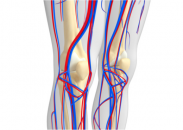Current models are not reliable when it comes to predicting events after carotid revascularization in acute patients. Peri-procedural events seem to be particularly hard to predict. The development of models that can be externally validated is essential for the decision-making process in patients with high event rates, both during the procedure or while the case…
Mortality in Peripheral Vascular Disease Drops Due to Revascularization
This cohort study shows that, from 2006 to 2015, the overall survival rate increased and the risk of major amputation decreased following lower limb revascularization. These population observations indicate that outcomes after lower limb revascularization have improved during the assessed period, and so have the centralization and specialization of interventional services. The availability and diversity…
More Evidence For MitraClip in High Risk Patients with Severe Tricuspid Regurgitation
Courtesy of Dr. Carlos Fava. Tricuspid regurgitation (TR) has a negative impact in the long run. Several reports have shown that, in high risk inoperable patients, transcatheter edge-to-edge valve repair with MitraClip is feasible, safe and has good results, but there is still a long way to go. The present study looked at 24 consecutive…
The Dangerous Combination of Complex Angioplasty and High Bleeding Risk Seems to Have a Solution
The LEADERS FREE trial demonstrated that a polymer-free Biolimus A9-coated stent (BioFreedom™DCS; Biosensors Europe, Morges, Switzerland) is superior to a conventional stent (bare metal stent, BMS) in patients with high bleeding risk treated with only one month of dual antiplatelet therapy. Now, is this global study outcome applicable in cases of complex lesions with several…
Perú Sessions: Young Interventionists Clinical Case Contest
“Fostering Hemodynamics among Young Cardiologists”. It is with great pleasure that we hereby invite all young Latin American cardiologists specializing in hemodynamics to submit relevant clinical cases to the next SOLACI Sessions, Lima, Perú, to be held on October 25th and 2nd, 2018. HOW TO PRESENT A CASE Case submission is meant for young Latin American…
Gradient vs. Flow to Determine Aortic Valve Stenosis Severity before and after TAVR
Pressure loss vs. flow curves offer a fundamental synthesis of fluids dynamics in describing aortic valve physiopathology. Severe aortic stenosis is not just an orifice (as suggested by Gorlin) or a segment that offers dynamic resistance. However, once a new transcatheter valve has been implanted, it will behave purely as a resistor. At dobutamine dose,…
Women in Cardiology: Still Underrepresented in a Field Full of Men
JAMA Cardiology dedicated a special with 4 articles on different issues women continue to face when considering this area of expertise, or when they have already chosen this fascinating field but still feel undervalued or discriminated compared with their male colleagues. One of the studies showed the career preferences of med school students. What trainees…
More Favorable Evidence for TAVR in Severe Aortic Regurgitation
Courtesy of Dr. Carlos Fava. Transcatheter aortic valve replacement (TAVR) was developed for aortic stenosis, but there is a significant number of patients with severe aortic regurgitation who still undergo this procedure as an off-label indication. Current evidence for this procedure in relation with this disease is growing, mainly due to good results obtained by different…
New European Hypertension Guidelines Contrast with American Recommendations
The European guidelines on hypertension have been updated and now feature differences compared with American guidelines regarding how to diagnose and treat patients with high blood pressure. The main difference particularly lies in how aggressive physicians should be in lowering blood pressure. These data are available from a preview of the document presented at the…
Can We Prevent Cardiovascular Events without Aspirin?
As regards the use of antithrombotic agents, the risk of bleeding will always be an issue, and in the case of aspirin this risk is twice as big: it does have the desired antiaggregation effect, but on top of the increased bleeding risk, it has a damaging effect on stomach lining that increases the risk…









